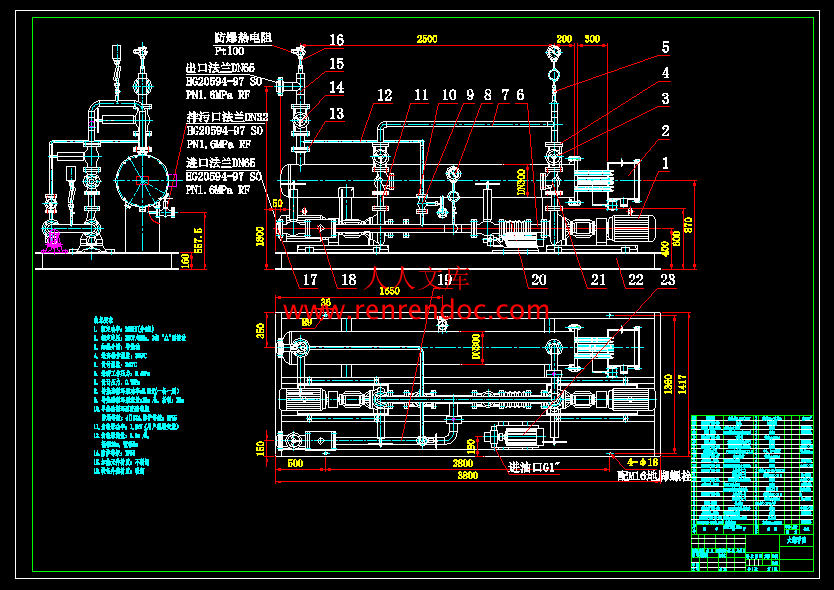一种基于电加热的导热油系统及其关键零部件的加工工艺设计
41页 22000字数+说明书+任务书+开题报告+外文翻译+工艺卡+工艺过程卡+8张CAD图纸【详情如下】
dn20机械加工工艺卡.doc
dn20机械加工工艺工序卡.doc
dn20机械加工工艺过程卡.doc
dn20毛坯.dwg
dn20法兰盘.dwg
DN50机械加工工艺卡.doc
DN50机械加工工艺工序卡.doc
DN50机械加工工艺过程卡.doc
DN50毛坯.dwg
DN50法兰.dwg
DN65机械加工工艺卡.doc
DN65机械加工工艺工序卡.doc
DN65机械加工工艺过程卡.doc
DN65毛坯图.dwg
DN65法兰.dwg
一种基于电加热的导热油系统及其关键零部件的加工工艺设计开题报告.doc
一种基于电加热的导热油系统及其关键零部件的加工工艺设计论文.doc
任务书.doc
外文翻译--机床加工介绍.doc
导热油-装配图.dwg
计划周记进度检查表.xls
部件图.dwg
摘要
了解流体传动的基本原理和接头的设计,同时运用机械专业知识,设计该系统中关键零部件的机械加工工艺。通过对电热油炉工作原理和电热油炉的使用及管理的了解,设计电加热导热油系统的整体装配图。根据所知的生产数据以及系统的运行要求,选用合理的零件进行装配。充分利用导热油系统,通过不断地技术改进和提高,来提高工厂的生产效益。同时对其关键零部件法兰盘进行机械加工工艺的分析,不同尺寸的法兰其加工余量是不同的,要根据法兰的大小正确的选取,保证零件加工的合理性。制定不同的工艺路线,通过对比选择合理的工艺路线。在确定加工余量后,根据加工工序的背吃刀量确定切削的进给量。粗取切削速度,计算出机床的主轴转速并选取机床的实际转速参数,算出实际切削速度。在法兰盘与管道的连接中,焊接也起了决定性作用,为了达到更好的焊接效果,需要对焊接填充材料进行选择。
关键词:导热油系统;工艺路线;切削用量;焊接
目录
摘要II
AbstractIII
目录V
1 绪论1
1.1 课题研究的意义1
1.2 课题研究的目的1
1.3 课题研究的范围1
1.4 达到的技术要求1
1.5 课题研究的内容1
1.5.1 加热器本体2
1.5.2 电加热导热油系统的特点2
2 整体设计3
2.1 整个系统里主要用到以下零部件4
3 部件的选用与设计5
3.1 高温法兰闸阀的选用5
3.2 导热油泵的选用5
3.3 压力表7
3.3.1 压力表的分类7
3.3.2 压力表的选用7
3.3.3 压力表的安装与日常维护8
3.4 加热熔器DN3008
3.5 电加热管芯的选用8
3.5.1 法兰电加热管8
3.5.2 法兰电加热管的特点9
3.6 止回阀的选用9
3.7 针型阀的选用10
3.8 防爆热电阻的选用10
3.9 过滤器的选用11
3.10 膨胀节的选用11
4 法兰盘的设计及制造工艺13
4.1 机加工工艺规程的步骤及原则13
4.2 法兰盘零件的分析14
4.2.1 法兰的作用14
4.2.2 零件的工艺分析14
4.3 工艺规程设计15
4.3.1 确定毛坯的制造形式15
4.3.2 基面的选择15
4.3.3 制定工艺路线15
4.3.4 机械加工余量、工序尺寸及毛坯尺寸的确定16
4.3.5 确定切削用量19
5 系统的管道焊接与装配29
5.1 焊接工艺的重要性29
5.2 焊接过程的物理本质29
5.3 焊接方法30
5.4 装配工艺规程30
5.4.1 装配的精度30
5.4.2 装配工艺规程的设计步骤31
6 结论与展望33
6.1 结论33
6.2 展望33
致 谢34
参考文献35
1 绪论
1.1 课题研究的意义
随着科学技术的进步和工业生产的发展,有机热载体炉得到了不断的发展和应用。虽然有机热载体炉的工作压力比较低,但是炉内热传导液温度高,且大多热传导液具有易燃易爆的特性,一旦在运行中发生泄漏,将会引起火灾、爆炸等事故,这样不仅有很重大的财产损失,严重的甚至会造成人员伤亡。因此,对有机热载体炉的安全运行和管理,必须高度重视,防患于未然。电热油炉作为一种直接的热能供给方式,已成为一种基础且关键的工业及民用设施。随着全球经济的快速增长,工业发展及城市建设步伐的不断加快,为电热产业带来了无限商机。
1.2 课题研究的目的
更加详细的了解电热油炉,熟悉它的工作原理,为电热油炉的发展做铺垫。了解电热油炉的使用和管理,充分利用导热油系统,通过不断地技术改进和提高,来提高工厂的生产效益。
1.3 课题研究的范围
电热油炉的很多部分都是焊接起来的,因此整个电热油炉的加工工艺规程中,焊接工艺在这个系统里起着举足轻重的作用,焊接的出错可能导致整个系统的失效,甚至引发整个系统的爆炸。电热油炉的机加工工艺规程中,除了焊接工艺,系统里其他很多零部件是机加工出来的,零件的大小,尺寸,都有明确的要求。电热油炉也分各种型号,所以并不是所有的电热油炉零件都通用。
系统的运行都是各个零部件组合在一起协同作用,所以正确地把各个零件组合起来是保障电加热系统稳定运行的充分条件,零件组装错误会导致系统的失效。电热油炉的电加热管芯因为是热油炉,所以他是用来传递热量的,那么用什么加热,如何加热很关键。加热管芯要考虑到电阻丝,氧化镁粉。油管法兰盘的工艺设计,这个系统密封性必须要严实,不然这个系统会漏油,从而热量也就损失了。使整个系统的效率下降,而浪费更多的资源。为了保障这个系统的长久运行,测温元件则能测量整个系统的温度,从而能更准确的利用系统。
1.4 达到的技术要求
可在较低的运行压力下,获得较高的工作温度,有效降低管线和锅炉的工作压力。热传导效率高、热损失小,升温快、降温慢。温度控制精确,受热相对均匀。成倍延长设备使用寿命。闭式循环和开式操作均安全可靠。节约能耗约50%左右,对大气烟尘排放减少一半。节油节水节电,对于沙漠缺水、高寒地区、缺电地区推广价值高。
1.5 课题研究的内容
电热式油加热器(电热油炉)是一种新型、节能、能提供高温热能的工业设备。供热原理:以电热升温,采用导热油作传热介质;在闭路循环系统中通过泵使热载体强制循环,在低压、高温状态下运行,直接释放热量,从而达到了提供热源的目的。经用热设备卸载后,重新通过循环泵,回到加热器,再吸收热量,传递给用热设备,如此周而复始,实现热量的连续传递,使被加热物体温度升高,达到加热的工艺要求。将热能输送给用热设备后,继加热→循环→再加热→再循环的特种工业油炉。
1.5.1 加热器本体?
1、加热器本体由锅炉钢结构组成,内胆经特殊防锈处理,外部采用耐高温涂料保护。
2、电加热器内采用“分层、逐节加热”技术成果。可以完全消除加热器内的“死角”,从而使重油在电加热器内循环流动,使重油受热均匀,不在容器内因停滞而产生结焦,从而消除因“死角”内的油品过热而产生的碳化和结焦。
3、热交换采用国外最新的多管、大面积换热结构。特粗三相单端出线电热元件与被加热的重油不直接接触,使换热管表面与被加热重油之间的温差大大降低,避免了重油的碳化现象。
4、电热元件采用远红外辐射技术,大大提高了传热效率,同时又降低了换热管的表面温度,从而进一步防止了油品因在换热管表面的局部过热而产生碳化和

 川公网安备: 51019002004831号
川公网安备: 51019002004831号